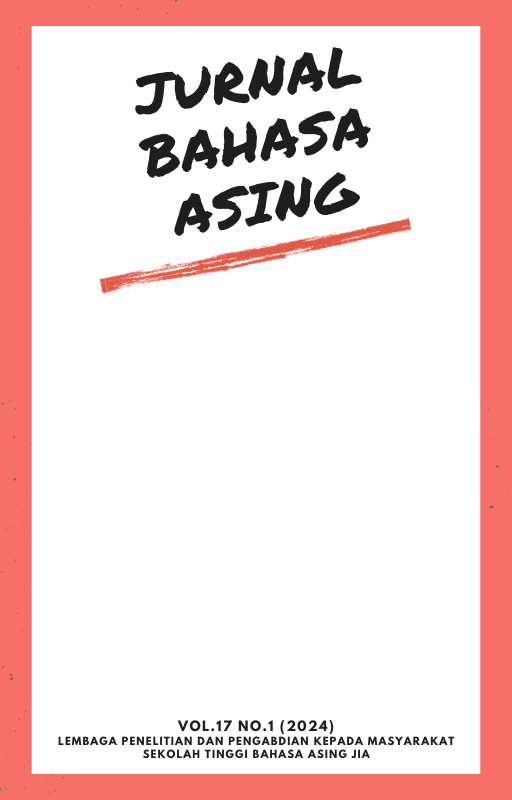Poetic Metaphors Related to Birds: A Conceptual Blending in Puisi-Puisi Cinta, WS. Rendra
DOI:
https://doi.org/10.58220/jba.v17i1.78Keywords:
Cognitive Linguistics, Conceptual Blending, Metaphor, Birds, Puisi-Puisi CintaAbstract
Metaphors are commonly used to vividly convey deeply abstract human emotions. This is because human emotions are indeed an abstract – conceptual. In the poem of Puisi-Puisi Cinta, the poet employs a great deal of emotional poetic metaphors relating to birds in order to communicate the variety of feelings that are experienced by the characters, such as features, roles, and visual aspects. This paper aims to study the emotional poetic metaphors related to birds in Puisi-Puisi Cinta using conceptual blending theory. The research data in the study consists the poetic metaphors related to Birds in Puisi – Pusi Cinta by WS Rendra. The data are conducted qualitatively using the blending theory. The blending theory’s G.Fauconnier and M.Turner (2002) came to the conclusion that metaphorizing is not limited by the projection from “the source domain” to “the target domain”, but includes complex dynamic integration processes, creating new blended mental spaces, which are able to create the meaning structure. The findings reveal that these vivid poetic metaphors in Puisi-Puisi Cinta by W.S Rendra are substantial through the use of imagery depicting aspects of the birds' appearances and its features to human beings. The metaphorical process, which projects from the birds to human beings, can be seen as a process of conceptual blending. In addition, each and every poetic metaphor related to birds of the poem has its characteristics in a certain cognitive model.
Downloads
References
Adu, S. J., Arief, H., & Sunarminto, T. (2023). Habitat and behavior of javan hawk-eagle (Nisaetus bartelsi) in SPTN 2 Majelengka Gunung Ciremai National Park, West Java. Jurnal Pengelolaan Sumberdaya Alam Dan Lingkungan (JPSL), 13(2), 332–340. https://doi.org/10.29244/jpsl.13.2.332-340
Al Masudi, H. H. B., & Daghir, S. C. (2017). Mental Spaces in Plath’s Mad Girl Love Song: A Cognitive Reading. Journal oF Basrah Research the Humanities Sciences, 42(5), 430–441. https://doi.org/10.33762/0694-042-005-018
Allen, D., Allum, M., & Flynn, S. (2014). A Charm of Magpies. Icon Books.
Evans, V. (2007). A Glossary of Cognitive Linguistics. Edinburgh University Press.
Fauconnier, G. (1985). Mental Spaces. MIT Press.
Fauconnier, G. (1994). Mental Spaces. Cambridge Univ. Pr.
Fauconnier, G. (1997). Mapping in Thought and Language. Cambridge Univ. Pr.
Fauconnier, G., & Sweetser, E. (1996). Spaces, worlds and grammar. Universitas of Chicago Press.
Fauconnier, G., & Turner, M. (2002). The Way We Think. Basic Books.
Hagstrum, J. (2013). Atmospheric Propagation Modeling Indicates Homing Pigeons Use Loft-specific Infrasonic ‘Map’ Cues. Journal of Experimental Biology, 216, 687–699. https://doi.org/10.1242/jeb.072934.
Hamad, N. I., Majeed, Prof. Dr. S. H., & Ezzaddin Ali, A. Prof. Dr. W. (2018). An Analysis of the Figures of Speech in Mental Spaces: A Cognitive Semantic Study. International Journal of Language & Linguistics, 5(2), 42–54. https://doi.org/10.30845/ijll.v5n2a6
Hanley, B. J., Dhondt, A. A., Forzan, M. J., Bunting, E. M., Pokras, M. A., Hynes, K. P., Dominguez-Villegas, E., & Schuler, K. L. (2022). Environmental lead reduces the resilience of bald eagle populations. The Journal of Wildlife Management, 86(2). https://doi.org/10.1002/jwmg.22177
Hanum, I. S., & Dahlan, D. (2018). Makna mitos cerita burung enggang di Kalimantan Timur. CaLLs, 4(1), 31–48.
Iskandar, B. S., Iskandar, J., & Partasasmita, R. (2019). Hobby and business on trading birds: Case study in bird market of Sukahaji, Bandung, West Java and Splendid, Malang, East Java (Indonesia). Biodiversitas, 20(5), 13116–1332.
Jianghua, H. (2019). A Conceptual Blending Approach to the Emotional Poetic Metaphors Related to Flowers in a Dream of Red Mansions. Scholars International Journal of Linguistics and Literature, 58–67.
Kövecses, Z. (2006). Language, Mind, and Culture: A Practical Introduction. Oxford Univ. Press.
Krieken, K. van, & Sanders, J. (2019). Smoothly moving through Mental Spaces: Linguistic patterns of viewpoint transfer in news narratives. Cognitive Linguistics, 30(3), 499–529. https://doi.org/10.1515/cog-2018-0063
Lakoff, G., & Johnson, M. (1980). Metaphors We Live By. Universitas of Chicago Press.
Lakoff, G., & Johnson, M. (2003). Metaphors We Live By (2nd ed.). University of Chicago Press.
Mulyanto, D., Iskandar, J., Gunawan, R., & Partasasmita, R. (2019). Ethnoornithology: Identification of bird names mentioned in Kakawin Rāmāyana, a 9th-century Javanese poem (Java, Indonesia). Biodiversitas, 20(11), 3213–3222.
Mustaqim, E., Kurtini, T., & Riyanti, R. (2016). Karakteristik Sifat Kualitatif Induk Murai Batu (Copsychus Malabaricus) Siap Produksi. Jurnal Ilmiah Peternakan Terpadu, 4(3), 204–2102.
Oakley, T., & Hougaard, A. (2008). Mental spaces in discourse and interaction. J. Benjamins.
Partasasmita, R., Atsuary, Z., & Husodo, T. (2017). The use of forest canopy by various bird species in tropical forest montana zone, the Nature Reserve of Mount Tilu, West Java, Indonesia. Biodiversitas, 18, 453–457.
Polak, J. (2017). The role of emergent structure in Conceptual Blending Theory – case studies of children in advertisements. Crossroads: A Journal of English Studies, 30–45. https://doi.org/10.15290/cr.2017.17.2.02
Ponomerava, O. B. (2015). Conceptual Integration in the Poetic Text. Procedia Social and Behaviour Science, 520–525.
Prasetyoningsih, T. W. S., Purwaningsih, D. R., & Yulianita, N. G. (2020). Animals as Symbols of Human Positive and Negative Traits on Javanese Expressions. Lingua Cultura, 14(2), 255–260.
Setiya, T. (2018, September 30). 10 Common Types of Eagles in Indonesia (#3 is Endemic). FactsofIndonesia.com. https://factsofindonesia.com/types-of-eagles-in-indonesia
Stenhouse, I. J. (2006). Bald Eagle (Haliaeetus leucocephalus alascanus) in The Coastal Forests and Mountains Ecoregion of Southeastern Alaska and the Tongass National Forest: A Conservation Assessment and Resource Synthesis. Audubon Alaska, The Nature Conservancy-Alaska.
Van der Mij, D. (2009). God, birds, and trees: Variation in illustrated Javanese Pawukon manuscripts. Wacana, 20(1), 135–174.
Walcott, C. (1996). Pigeon Homing: Observations, Experiments and Confusions. Journal of Experimental Biology, 199(1), 21–27. https://doi.org/10.1242/jeb.199.1.21
Wang, W. (2007). The cognitive construction and interpretation of metaphor. Shanghai Foreign Language Education Press.
Wijana, I. D. P. (2018). Metaphors of Animal Names in Indonesian. Deskripsi Bahasa, 1(1), 1–8.
Wulukada, H. H., Hakim, A., Sugiyanto, & Isrok. (2017). Dimension of Garuda Bird Environment Philosophy as a Symbol of National and State Life of Indonesia. International Journal of Humanities, Religion and Social Science, 3(1), 58–71.
Yang, C. (2021). Poetic Association: Conceptual Blending in In a Station of the Metro. Academic Journal of Humanities & Social Sciences, 4(4), 61–66.
Zaťko, R. (2020). Symbolism of the Eagle and Jaguar in the Novel City of the Beasts by Isabel Allende. Ethnologia Actualis, 20(1), 70–87. https://doi.org/10.2478/eas-2021-0004
Zhao, G. Z., & Duan, H. B. (2017). Progresses in biological eagle-eye vision technology. Scientia Sinica (Technologica), 47(5), 514–523.
Downloads
Published
How to Cite
Issue
Section
License
Copyright (c) 2024 Haidar Jaganegara

This work is licensed under a Creative Commons Attribution-NonCommercial-ShareAlike 4.0 International License.
The submission has not been previously published, nor is it before another journal for consideration.
Pengajuan belum pernah dipublikasikan sebelumnya, juga tidak sebelum jurnal lain untuk dipertimbangkan.















